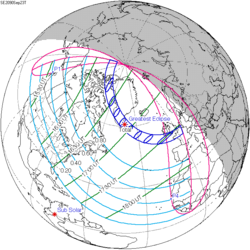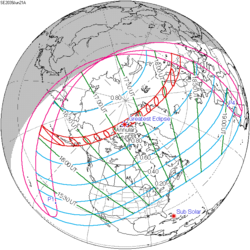| Partial eclipse | |
| Gamma | 1.0215 |
|---|---|
| Magnitude | 0.9793 |
| Maximum eclipse | |
| Coordinates | 71°42′N82°18′W / 71.7°N 82.3°W |
| Times (UTC) | |
| Greatest eclipse | 1:09:34 |
| References | |
| Saros | 155 (8 of 71) |
| Catalog # (SE5000) | 9628 |
A partial solar eclipse will occur at the Moon's ascending node of orbit between Tuesday, September 1 and Wednesday, September 2, 2054, [1] with a magnitude of 0.9793. A solar eclipse occurs when the Moon passes between Earth and the Sun, thereby totally or partly obscuring the image of the Sun for a viewer on Earth. A partial solar eclipse occurs in the polar regions of the Earth when the center of the Moon's shadow misses the Earth.
Contents
- Eclipse details
- Eclipse season
- Related eclipses
- Eclipses in 2054
- Metonic
- Tzolkinex
- Half-Saros
- Tritos
- Solar Saros 155
- Inex
- Triad
- Solar eclipses of 2051–2054
- Saros 155
- Metonic series
- Tritos series
- Inex series
- References
- External links
The partial solar eclipse will be visible for parts of Northeast Asia, Alaska, western Canada, and the western United States. This is the last of the first set of partial eclipses in Solar Saros 155.























































































